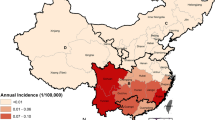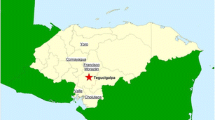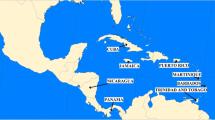Abstract
The purpose of this study was the observation of eventual shifts in some basic epidemiological features of human leptospirosis in Slovakia over a long period of time. Epidemiological traits of human leptospirosis were evaluated in three decades: 1954–1963 (822 cases), 1976–1985 (477 cases) and 1997–2006 (310 cases). The evaluation encompassed the aetiologic structure of cases, the incidence rate of diseases, men-to-women ratio of patients, as well as the professional and seasonal distribution of patients. The most affected feature was the incidence rate, which decreased by more than 70% over time. Another considerable change was the proportion of different major serological types of leptospirosis. The initially prevailing Sejroe infections fell to 4th place in the percentage rank, while Grippotyphosa disease, which was ranked 2nd place at the beginning of the observations, became dominating. Icterohaemorrhagiae disease climbed from 4th place to 2nd place. Third place was reserved by the Pomona + Tarassovi infections during the whole study period. A distinct tendency of age- and gender-specific incidence rate compared to the proportion of leptospirosis by age and gender was noticed; only minor alterations of the values of both parameters were registered over time. The overall value of the men-to-women ratio (MWR) of diseased persons was virtually within the same range in all three time periods but varied according to different age groups. The MWRs relative to the causal Leptospira serovars were stable over time but markedly differed among distinct serovars. Incidence rates related to age and aetiology showed different trends for the major serological types of leptospirosis. Changes were observed in the professional distribution of leptospirosis: there was an important proportional decrease of cases among farmers and field workers, an increase among house-wives + pensioners, but only some slight changes in abattoir workers/butchers, pupils + students and workers. The seasonal distribution of patients did not show any remarkable changes; the maximum percentage of cases occurred during the period extending from July to November during the whole period of observation. The epidemiological features of human leptospirosis underwent important shifts in the Slovak Republic over a 50-year period of time. They were very closely related to economical, social and political changes, which are discussed in this paper. The results may be useful for specialists in other European countries.







Similar content being viewed by others
References
Shenberg E, Gerichter CB, Lindenbaum I (1982) Leptospirosis in man, Israel, 1970–1979. Am J Epidemiol 115:352–358
Gsell O (1990) The changing epidemiology of leptospirosis in Europe. A report on the 6th meeting of European Leptospira workers, Brno, Czechoslovakia, September 1988. Zentralbl Bakteriol 273:412–427
Cacciapuoti B, Ciceroni L, Pinto A et al (1994) Survey on the prevalence of leptospira infections in the Italian population. Eur J Epidemiol 10:173–180
Ciceroni L, Pinto A, Benedetti E et al (1995) Human leptospirosis in Italy, 1986–1993. Eur J Epidemiol 11:707–710
Everard COR, Edwards CN, Everard JD et al (1995) A twelve-year study of leptospirosis on Barbados. Eur J Epidemiol 11:311–320
Ciceroni L, Stepan E, Pinto A et al (2000) Epidemiological trend of human leptospirosis in Italy between 1994 and 1996. Eur J Epidemiol 16:79–86
Kariv R, Klempfner R, Barnea A et al (2001) The changing epidemiology of leptospirosis in Israel. Emerg Infect Dis 7:990–992
Thornley CN, Baker MG, Weinstein P et al (2002) Changing epidemiology of human leptospirosis in New Zealand. Epidemiol Infect 128:29–36
Zitek K, Beneš Č (2005) Long-term epidemiology of leptospirosis (1963–2003) in the Czech republic (in Czech). Epidemiol Mikrobiol Imunol (Prague) 54:21–26
Jansen A, Schöneberg I, Frank C et al (2005) Leptospirosis in Germany, 1962–2003. Emerg Infect Dis 11:1048–1054
Pond KR (2005) Water recreation and disease:plausibility of associated infections : acute effects, sequelae, and mortality. IWA Publishing, London, 239 pp
Baranton G, Postic D (2006) Trends in leptospirosis epidemiology in France. Sixty-six years of passive serological surveillance from 1920 to 2003. Int J Infect Dis 10:162–170
Storck CH, Postic D, Lamaury I et al (2008) Changes in epidemiology of leptospirosis in 2003–2004, a two El Niño Southern Oscillation period, Guadeloupe archipelago, French West Indies. Epidemiol Infect 136:1407–1415
Bakoss P, Macháčová E, Sláčiková M (1996) Changes in the epidemiology of human leptospirosis in the Slovak Republic (in Slovak). Bratisl Lek Listy 97:123–130
Surveillance of zoonoses. Slovak Republic. Leptospiroses (1970–2006, separate issue for each calender year). Institute of Veterinary Information Culture, Bratislava (till 1986), State Veterinary and Food Administration of the Slovak Republic, Bratislava (since 1987) (in Slovak)
Kmety E, Rehácek J, Výrosteková V et al (1993) Epidemiology (in Slovak). Igor Dráb, Bratislava, 128 pp
European Centre for Disease Prevention and Control (ECDC) (2009) Leptospirosis. In: Surveillance report. Annual epidemiological report on communicable diseases in Europe, 2009. ECDC, pp 102–104
Pappas G, Papadimitriou P, Siozopoulou V et al (2008) The globalization of leptospirosis: worldwide incidence trends. Int J Infect Dis 12:351–357
Mittermayer T, Rojkovič D, Kmety E (1961) Leptospirosis in Eastern Slovakia. Certain natural infections of focal character in Eastern Slovakia (in Slovak). Regional Publishing Institute of Common Literature, Košice, pp 131–163
Olszyna DP, Jaspars R, Speelman P et al (1998) Leptospirosis in the Netherlands, 1991–1995 (in Dutch). Ned Tijdschr Geneeskd 142:1270–1273
Persons working in Slovak economy. In: Statistical yearbook of the Czechoslovak Republic (1964). State Publishing House of Technical Literature, Prague, 577 pp (in Czech)
Persons working in national economy. In: Statistical yearbook of the Czechoslovak Republic (1981). Publishing House of Technical Literature, Prague, 696 pp (in Czech)
Persons working in economy. In: Statistical yearbook of the Slovak Republic (2007). Publishing House VEDA, 688 pp (in Slovak)
Christova I, Tasseva E, Manev H (2003) Human leptospirosis in Bulgaria, 1989–2001: epidemiological, clinical, and serological features. Scand J Infect Dis 35:869–872
Acknowledgement
The study was supported, in part, by the Slovak Grant Agency VEGA, project no. 1/0426/11.
Declaration
The authors declare that they have no conflicts of interest.
The authors also declare that the presented paper has not been published before and is not under consideration for publication elsewhere. Its publication has been approved by both co-authors as well as by the Head of the Department of Epidemiology.
Author information
Authors and Affiliations
Corresponding author
Rights and permissions
About this article
Cite this article
Bakoss, P., Macháčová, E. & Jareková, J. Long-term trends in the epidemiology of human leptospirosis (Slovak Republic, 1954–2006). Eur J Clin Microbiol Infect Dis 31, 2167–2176 (2012). https://doi.org/10.1007/s10096-012-1551-8
Received:
Accepted:
Published:
Issue Date:
DOI: https://doi.org/10.1007/s10096-012-1551-8




